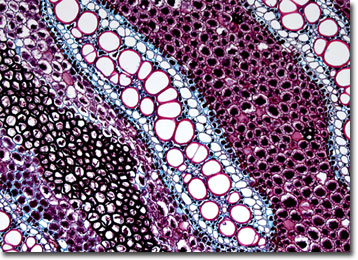Brightfield Microscopy Digital Image Gallery
Bracken Fern (Pteridium) Rhizome
Bracken is the common name of a type of tall, widespread fern that is the sole species classified in the genus Pteridium of the family Polypodiaceae. The plant, which is often considered a troublesome weed, is also sometimes alternatively known as brake.

A number of different animals feed on bracken ferns, although they can be toxic if they are consumed in too great a quantity. The most palatable parts of the plant are the young fronds and the rhizome, a subterranean horizontal stem from which an extensive collection of roots and shoots extend. Interestingly, when the fronds of the bracken fern become damaged they release hydrogen cyanide gas. Some herbivores, such as sheep, are able to detect this substance, ensuring their avoidance of spoiled leaves.
Although modern ranchers and wildlife managers often consider bracken ferns a nuisance, they may be utilized by humans in a variety of ways. In fact, they were so valued in the Middle Ages, when they were commonly used as a source of fuel and as a roofing material, that they could be used as a sort of currency. Bracken ferns were also widely used at one time in the production of potash and bleach, and continue to be utilized in some locales as a food source and as bedding for cattle. The rhizomes of the plants are especially useful. Their extracts can be used to dye wool and tan leather, their starch can be used as a type of flour, and they may even possess medicinal qualities, having been utilized both as a treatment for bronchitis and parasitic worm infections.
BACK TO THE BRIGHTFIELD MICROSCOPY IMAGE GALLERY
